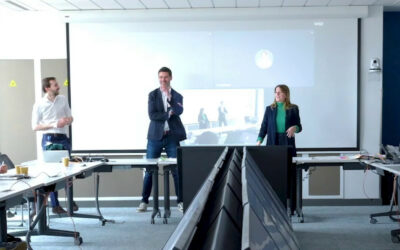How to combine trust and blockchain? Crisis is a time for opportunities. During the last months, we have all faced this peculiar moment: Coming to the grocery store several days in a row when demand for pasta, eggs or wheat was peaking, and having to go for a product for which packaging, provenance or labels are not familiar.
Some of us accepted this forced substitution because we trusted our retailer. Suddenly, trust in food, which was already a “must” in light of new consumption behaviours, became even more important because of Covid-19.
Trust is a complex phenomenon. In fact, the word has more synonyms in the anglo-saxon world than in the latin universe: Reliability, confidence, reliance, faith, belief… Trust means predictability, in economics as in sociology. In computer science, trust also refers to the ability to communicate and verify information (through certificates, for instance).
The first steps of Carrefour in blockchain
Back in 2018, Carrefour announced its commitment to leverage blockchain so we can guarantee our customers they can trust the food produced, packaged and distributed by the broader food community of farmers, manufacturers, processors and logistic operators. This was the beginning of an amazing journey, both in terms of customer value and of technological progress.
This vision was grounded on the ambition of a more sustainable everyday life. Each time a customer will flash a QR code with his / her smartphone, he / she will be able to access concrete proofs on its origin, quality and security. All this with the right level of granularity (batch number) and ensuring the maximum level of accuracy, since the blockchain is “immutable” and does not let any room to fake information.
And, needless to say, it builds a “halo effect”.
“If I can trust Carrefour with this chicken, I can also trust Carrefour for their apples or cheese“
–
A pragmatic, collaborative approach to improve the lives of our customers
Right from the start, we identified three major principles for our blockchain program:
- Team autonomy as a lever of innovation.
- Food communities..
- Customer orientation.
Firstly, our “do-it-ourselves” approach can be linked to the fact that significant autonomy was offered for the team: We wanted a fail-fast approach in order to learn deeply and quickly by getting our hands dirty.
Blockchain being a highly innovative initiative, we decided to give the team a strong degree of freedom to define the different technological layers of the product. We built all the different components of our blockchain platform from scratch over four months using the Ethereum framework. Excitement and motivation grew within the team: In three days, the team had a private ledger running to start playing. We got as a result a robust tech architecture, the capability to migrate to Hyperledger Fabric (always in an open-source philosophy) and,a few years later, some components designed in the early stages still into everyday productive use.
Secondly, the community-based approach with our suppliers and partners in food production and transport was a key pillar of the project.
Let us illustrate the starting point with an example: The Carrefour Quality Line (CQL) chicken was subject to a substantial volume of claims, including questions about it being free of antibiotics, non-GMO and free-range breeded. To address this issue, we brought onboard cereal producers, farmers, unions, veterinarians and slaughtering facilities. We put them in the same table and made clear that it was crucial to work together to ensure high quality data to create trust with customers.
From the first Tweet we positioned blockchain as an enabler of our CQLs, bringing value as a way to federate the efforts of the food community.
Thirdly, aligning the community around a common vision was easy thanks to our shared purpose of creating added value for our customers: Our true intent was to give back as much information as possible, being straightforward enough to “open the books” to all the data that we had been gathering for years. We had the opportunity to conduct several roundtables to ask our customers what products they would like to see blockchained and what type of information was important for them. It was at this moment that we realized that telling the “little story” behind every farmer of Chavignol cheese was a strong factor of reassurance for the customer -as well as a nice way to draw a fair amount of well-deserved attention to all the work of local producers and, more generally, actors of the food chain.
All in all, technology was not an ambition per se. The blockchain program was rather a highly innovative and engaging adventure for Carrefour employees, who were able to express their passion to empower the entire food community in its quest to offer high quality products to the customer.
The road so far
Since then, more than 30 products in 6 countries have been blockchained.
Each of them onboarding multiple SKUs. Each of them with their own specificities and stakeholders. Each of them with the same spirit of making producers and quality experts work hand in hand.
Today, Carrefour is, after Walmart, the largest powerhouse of food blockchain services in the world.
The blockchain journey for Carrefour is not over! We still have a lot of ground to cover:
- Sustained delivery – Keep on blockchaining our products, both in France and internationally.
- KPIs – We are now working on improving the way we measure key outcomes that help us continuously improve the quality of the food sold to our customers.
- Communication – We certainly have room to better inform our customers about our blockchain capabilities and how to access them.
- Technical simplification – After the initial period of experimentation we decided to generalize the use of IBM Food Trust for Carrefour countries to rationalize our technical platforms.
- Going one step further – And last but not least, we are exploring new usages for blockchain, apart from food traceability, such as transport traceability.
Check our other tech projects on Horizons.




